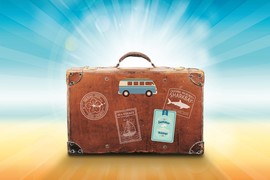Patient Education
Summer Travel Tips
 You may be thinking about taking a summer vacation over the next few months, and while this may sound exciting, it has the potential to be a little hazardous to your health. Travelling results in prolonged periods of sitting in awkward, cramped spaces, whether it be in a car or on a plane, and possibly prolonged periods of standing while waiting in lineups at airports in combination with heavy lifting of luggage. Dehydration is very common with travel too.
You may be thinking about taking a summer vacation over the next few months, and while this may sound exciting, it has the potential to be a little hazardous to your health. Travelling results in prolonged periods of sitting in awkward, cramped spaces, whether it be in a car or on a plane, and possibly prolonged periods of standing while waiting in lineups at airports in combination with heavy lifting of luggage. Dehydration is very common with travel too.
All of these seemingly harmless activities can increase stress on the joints of your body, resulting in pain and discomfort. Additionally, one of the most serious consequences of travelling is that prolonged periods of travel increase the risk of suffering from a blood clot (deep vein thrombosis), which may result in a serious issue if the blood clot breaks off and travels to the lung, resulting in a pulmonary embolism.
The good news is that by following some simple summer travel tips, you can minimize the risk of suffering an injury so that you can fully enjoy your summer vacation.
Tip 1 – Lift Luggage Properly
The first step to safe travelling is to pack your luggage as light as possible; this will help to minimize the weight that you have to lift when transporting your luggage. When walking with luggage, use a cart whenever possible to avoid carrying weight unnecessarily. When lifting luggage, use a proper lifting technique which involves carrying the luggage as close to your body as possible and lifting with your legs as opposed to your back and avoiding twisting movements.
Tip 2 – Mind Your Posture
Whether sitting in your car or on an airplane, be mindful of your posture. Think about sitting tall with a lifted chest, relaxed shoulders and tucked and level chin. Adjust your seat to maximize comfort by positioning your seat to ensure that your back is supported and legs are relaxed, and use a back support if necessary.
Tip 3 – Take Breaks
If you’re driving, make frequent stops to get out of your car and stretch your legs and back. If you’re on an airplane, especially during a long flight, get out of your seat often and walk up and down the aisle. Further, while seated on an airplane, pump your ankles up and down to get blood flowing in your legs.
Tip 4 – Know the Signs of Deep Vein Thrombosis (DVT) and Pulmonary Embolism (PE)
Being aware of the signs and symptoms of DVT and PE can help to ensure timely medical intervention, which can help to reduce the severity of the condition. The most common symptoms of DVT include: swelling, unexplained pain or tenderness, skin warmth and redness in the affected extremity. DVT occurs most frequently in the lower leg and can feel like a calf muscle cramp initially. Not all patients with PE will have signs and symptoms of DVT. The most common signs and symptoms of PE include: breathing difficulty, irregular or fast heartbeat, chest discomfort or pain that is often worsened with deep breathing or coughing, anxiety, coughing blood, fainting or a feeling of light-headedness.
If a current or previous injury is preventing you from taking a relaxing summer vacation, you may benefit from physiotherapy, which often involves therapeutic massage, manual therapy, and muscle stimulation techniques, as well as learning how to perform stretching and strength training exercises correctly. A physiotherapist typically guides the sessions in order to monitor your progress and ensure progression towards optimal healing.
Undergoing a comprehensive physical examination by Physiotherapists at Skill Builders is one of the best ways to gain an understanding of how you can improve your optimal health. After your assessment, our physiotherapists will create an individualized program that can help to improve your recovery time, and provide you with optimal health benefits.
References
1. Blood Clots and Travel: What You Need to Know | DVT/PE | NCBDDD | CDC. Cdcgov. 2016. Available at: http://www.cdc.gov/ncbddd/dvt/travel.html. Accessed April 18, 2016.
2. Cemal Y, Pusic A, Mehrara B. Preventative Measures for Lymphedema: Separating Fact from Fiction. Journal of the American College of Surgeons. 2011;213(4):543-551. doi:10.1016/j.jamcollsurg.2011.07.001.
3. Kuipers S, Cannegieter S, Middeldorp S, Robyn L, Büller H, Rosendaal F. The Absolute Risk of Venous Thrombosis after Air Travel: A Cohort Study of 8,755 Employees of International Organisations. PLoS Med. 2007;4(9):e290. doi:10.1371/journal.pmed.0040290.
4. O'Donovan K, Bajd T, Grace P, O'Keeffe D, Lyons G. Preliminary Evaluation of Recommended Airline Exercises for Optimal Calf Muscle Pump Activity. EJVES Extra. 2006;12(1):1-5. doi:10.1016/j.ejvsextra.2006.04.001.
